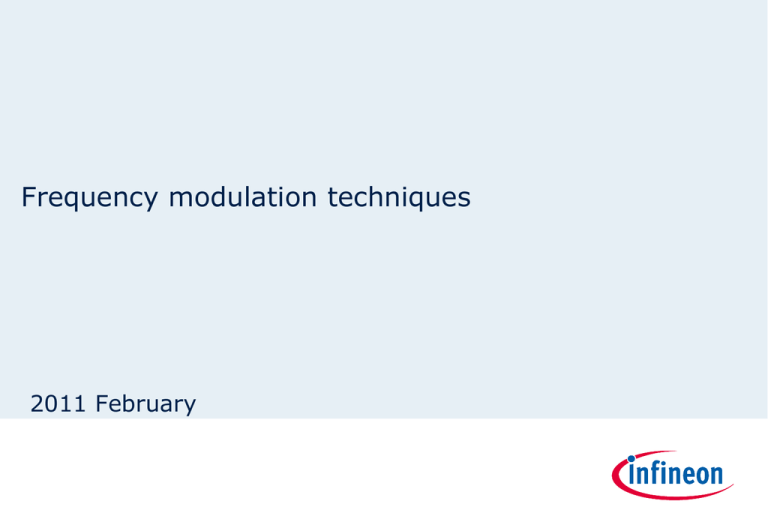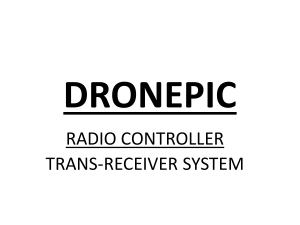Frequency modulation techniques
advertisement

Frequency modulation techniques 2011 February Overview of FM modulation techniques Advantages Disadvantage Switched capacitor a chip-internal transistor is switched ON and OFF by the modulating signal. The frequency is pulled (between FSK_low and FSK_high) values due to this additional (switched ) capacitor simple, robust, easy to implement the maximum frequency shift is determined mainly by parameters of the crystal ( crystal pullability) and works “on the fly” , no need to program anything, just apply the power and the modulating and control signal the crystal pulling is achieved over a varactor for higher demands of linearity a pair of varactors may be connected into antiparalel group Typical representatives The solution can be applied to the TDK510x ; TDK511x and PMA5110 / PMA71xx family Digital modulator Frequency shift setting capacitor Load capacitor for crystal unwanted but low energy transients may appear in spectrum due to capacitor switching PMA5110 and PMA7105; PMA7106; PMA7107; PMA7110 family With external varactor Key feature Modulation signal (applied to FSKDTA pin) careful selection for value of the frequency setting capacitor (C ) is required tradeoff between startup time and frequency shift capability (due to inherent nature of crystal resonators) Typical representatives TDK510x and TDK511x family Block diagram Low cost , simple solutions Short description clean, predictable spectrum, very low amount of transients, less sideband noise as by switched capacitor type modulator works “on the fly” , no need to program anything, just apply the power and the modulating signal the digital modulation is achieved by seamlessly changing the division ratio of a Fractional-N type synthesizer between two “end” frequencies almost unlimited freedom in setting the size and shape of frequency shift vs. time function switchover between FSK and GFSK over software (by reprogramming some of SFR registers) Typical representatives TDA5150 transmitter, TDA5340 transceiver no special crystal pullability requirements, the crystal swings always on same frequency well suited for multichannel systems for identical modulation indexes the occupied bandwidth (OBW) of a GFSK signal is less then of a FSK signal, thus GFSK is more effective in terms of spectrum usage The maximum frequency shift is determined by: parameters of the crystal used in application (-->crystal pullability) and varactor characteristics (i.e. Cmax/Cmin ratio ) Modulation signal (applied to varactor) RF blocking coil limitations regarding Cmin / Cmax capacitance variation (of varactor) due to low power supply voltage and limited modulation signal voltage swing to avoid (minimize) fractional spurs some rules in choice of the synthesizer’s fractional part ratio have to be obeyed Note: this does not limit the system’s flexibility in terms of reference clock selection a Host (usually microcontroller) is required to program the chip before transmission can be started Note: this is not a real drawback, as by most practical applications a microcontroller is part of the system. Steering functions and modulation signal (data stream) are derived usually from the uC unit. RF rejection capacitor XOSC clock Frequency word Gauss Divider division Ratio Gauss Filter FSK / GFSK data Mode (FSK; GFSK; ASK) - Arithmetic Unit modulator Adder Divider Ratio Control (to Multimodulus Divider Unit) TDA5150; Digital Modulator block Easy design-in High flexibility, Multiband, multichannel Modulator type
